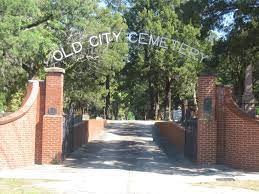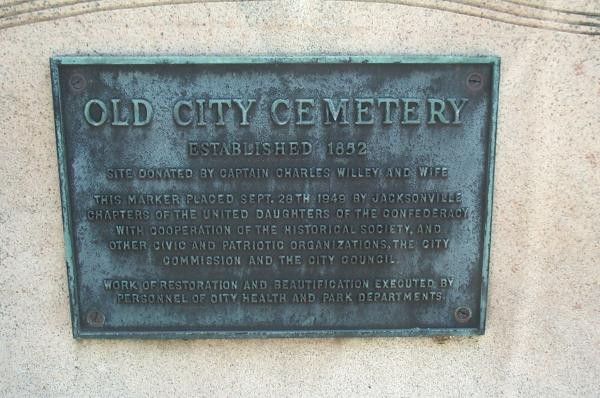Old City Cemetery of Jacksonville, Florida
Introduction
Text-to-speech Audio
The Old City Cemetery of Jacksonville, Florida plays a key role in looking back into the history of Northeast Florida. With graves dating back to as early as 1857 and the majority of bodies laid to rest here being of Black, Hispanic, Cuban, and Hebrew people, the Old City Cemetery is hugely relevant to Jacksonville’s deep culturally diverse history and also American history as it also houses a number of confederate graves. This site served as Jacksonville’s main graveyard around the time of its institution in 1852.
Images
Entrance to Old City Cemetery

Entrance plaque to Old City Cemetery

Backstory and Context
Text-to-speech Audio
The land now housing Jacksonville’s Old City Cemetery was originally owned by Captain Charles Wiley, a trade master responsible for the transport and trade of goods between northeast Florida and New York. It is noted that the grounds had been previously used as a burial site, however not used officially as a cemetery until Captain Wiley gifted the land to the City of Jacksonville in 1852.
Captain Wiley was a trade master who travelled between St. Johns and New York via Schooner. He wrote seven letters that have been edited, three being addressed from Jacksonville and four from New York, that offered commentary on his work and travels up and down the east coast of America. His ship’s cargo typically ranged from grains to vegetables, meat and fish and assortments of alcohol. At the time of Captain Wiley’s residence in Jacksonville in the mid 1800s, it is written that the city was a stark contrast to what it is today, merely a village with only around 400 residents with only one main street. Once Captain Wiley gifted his plot of land to the city, it became the primary burial ground at the time.
Philip S. May of the Jacksonville Historical Society notably stated:
“On this little tract of land (the Old City Cemetery of Jacksonville). . . are situated practically all of Jacksonville’s physical links with its past.”
May made great point with this quote as the Old City Cemetery of Jacksonville shows us the truly diverse history of the city. Along with a section for both Black and White Confederate soldiers, it also had dedicated sections for blacks, Hebrews, Cubans, and Hispanic peoples all dating back as far as 1852.
Sources
Edwards, L. A. (1956). Stories in Stone. The Florida Historical Quarterly, 35(2), 116–129. 23 Feb. 2023. This article discusses different Jacksonville grave sites, including Old City Cemetery, so it is helpful for general context around Jacksonville’s many historic cemeteries. Across the street from Old City Cemetery there was also a dedicated Catholic Cemetery, and although they are separated by a narrow road and from the same period, and believed to both be land formerly owned by Captain Wiley, are considered separate. Early graves date back to 1857. Old City Cemetery had dedicated separate sections for confederate soldiers, blacks, hebrews, and ministers (127). I accessed this article via UCF research website. It is dated but provides key details to how the cemetery was set up and context into Jacksonville’s other cemeteries. Society, Florida Historical (1949) "The Jacksonville Historical Society," Florida Historical Quarterly: Vol. 28 : No. 3, Article 8. 23 Feb. 2023. This article discusses the origin of Jacksonville, Florida’s Old City Cemetery. This cemetery dates back to 1852 when the plot of land was gifted to the city by trade master Captain Charles Wiley who spent his time between New York and Jacksonville selling and trading goods. It is noted that the plot of land had been previously used as a burial site. This cite has been referred to by historians as a view into all of Jacksonville’s deep past. I accessed this article via UCF research website, and although the article is from 1949, it still provides relevant, important details to the history of this historical jacksonville cemetery. Helmick, G. (2016). U.s. Cuban Populations In Jacksonville, Florida, Before And After Jim Crow (1876-1960). National Association of African American Studies. This recent article sheds light into the Old City Cemetery’s use and relevance of Jacksonville’s deep culturally diverse history. It gives information on the cemetery’s use for black, hispanic, and cuban peoples living in Jacksonville between the late 1870s and the 1960s, before and after the effect of Jim Crow laws. I found this source through Google Scholar.
Brown, Brittany, "Ancestral Landscapes: a Study of Historical Black Cemeteries and Contemporary Practices of Commemoration Among African Americans in Duval County, Jacksonville, Fl." (2018). Dissertations, Theses, and Masters Projects. William & Mary. Paper 1550154005.
Helmick, Gregory. "U.S. CUBAN POPULATIONS IN JACKSONVILLE, FLORIDA, BEFORE AND AFTER JIM CROW (1876-1960)". NAAAS Conference Proceedings; Scarborough Scarborough: National Association of African American Studies. (2016): 1017-1042.
https://www.jacksonville.com/story/news/2017/04/09/old-city-cemetery-history-museum/15750062007/
https://www.jacksonville.com/story/news/2017/04/09/old-city-cemetery-history-museum/15750062007/
